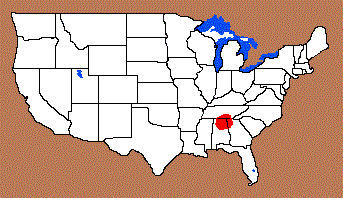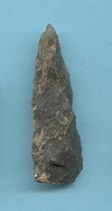Outline is Representative of Size and Shape:


Name Details:
Identified By: William Webb and David Dejarnette
Named For: Type Site
Date Identified: 1948
Type Site: Flint River Mound Site, Madison County, Alabama
Identified By: William Webb and David Dejarnette
Named For: Type Site
Date Identified: 1948
Type Site: Flint River Mound Site, Madison County, Alabama
Point Validity:
Valid type
Webb began his academic career as a physicist working in the Department of Physic at the University of Kentucky in 1908. He contributed to the founding, and became the Department Chair for the Department of Anthropology at the University of Kentucky in 1926. Dejarnette what the first anthropologist hired by the University of Alabama and was an expert on southeastern archaeology. This point was named in a personally published book. This point has been referred to in numerous professional publications and is considered a valid type.
Webb began his academic career as a physicist working in the Department of Physic at the University of Kentucky in 1908. He contributed to the founding, and became the Department Chair for the Department of Anthropology at the University of Kentucky in 1926. Dejarnette what the first anthropologist hired by the University of Alabama and was an expert on southeastern archaeology. This point was named in a personally published book. This point has been referred to in numerous professional publications and is considered a valid type.
Flint River Spike
Cluster: Description of Physical Characteristics and Flaking Pattern:
This is a small to medium ovoid thick narrow point. The cross section is primarily elliptical, but may also have a medial ridge or in some thicker examples may almost be round. The blade may range from excurvate to straight. This point may have one or two weak shoulders and almost a contracting stem appearance. The base ranges from straight to convex and may be unfinished, have basal grinding, or thinning. This point has a random flaking pattern.
Size Measurements:
Total Length - 39 to 58 mm (50 mm average), Width - 12 to 21 mm (16 mm average), Thickness - 7 to 11 mm
Total Length - 39 to 58 mm (50 mm average), Width - 12 to 21 mm (16 mm average), Thickness - 7 to 11 mm
Commonly Utilized Material:
Additional Comments:
This point is similar (and possibly a variation) to the Bradley Spike point, except, this point does not have a stem like the Bradley Spike point (Cambron, 1969).
Schroder (W18) notes the difference between the spike type points found in Georgia and Florida. He points out that the Bradley Spike has a stem that varies from straight to contracting with a pointed base. The Duval point has a straight to bulbous style stem. The Flint River point has a rounded stem. The New Market point has a contracting stem. The Schild point has a short straight to slightly expanding stem, and the Florida Spike has a straight to contracting stem with a straight base. The name Woodland Spike was a term used by Whatley that lumped all the Woodland period spike type points into a single category. Farr credits Whatley for the term Woodland Spike while Schroder credits Jerald Ledbetter for the name.
This point is similar (and possibly a variation) to the Bradley Spike point, except, this point does not have a stem like the Bradley Spike point (Cambron, 1969).
Schroder (W18) notes the difference between the spike type points found in Georgia and Florida. He points out that the Bradley Spike has a stem that varies from straight to contracting with a pointed base. The Duval point has a straight to bulbous style stem. The Flint River point has a rounded stem. The New Market point has a contracting stem. The Schild point has a short straight to slightly expanding stem, and the Florida Spike has a straight to contracting stem with a straight base. The name Woodland Spike was a term used by Whatley that lumped all the Woodland period spike type points into a single category. Farr credits Whatley for the term Woodland Spike while Schroder credits Jerald Ledbetter for the name.
Distribution:

Distribution Comments:
This point is primarily found in northern Alabama into southern Tennessee and northwestern Georgia. The full distribution is not known, but is probably found through-out the Tennessee River Valley and has the same distribution as the Bradley Spike.
This point is primarily found in northern Alabama into southern Tennessee and northwestern Georgia. The full distribution is not known, but is probably found through-out the Tennessee River Valley and has the same distribution as the Bradley Spike.
Age / Periods:
Date: 1,800 - 1,300 B.P.
Cultural Period: Middle to Late Woodland
Glacial Period: Roman Warm to Vandal Minimum
Culture:
Date: 1,800 - 1,300 B.P.
Cultural Period: Middle to Late Woodland
Glacial Period: Roman Warm to Vandal Minimum
Culture:
Age Details:
Other points in this cluster / Related / Associated Points:
Bradley Spike
Bradley Spike



